Pauline Studies Collection, 28 vols. (Library of New Testament Studies | LNTS/JSNTS)
Digital Logos Edition
Overview
These selected works, from the Library of New Testament Studies, represent some of the most up-to-date, in-depth, and authoritative research in Pauline studies and cover some of the most hotly debated topics in the field. Several volumes bring to light new research and proposals on Paul in the context of Second Temple Judaism and the Greco-Roman world. The New Perspective on Paul is also a major focus of several volumes in the collection, including a recent festschrift for James Dunn, which demonstrates his far-reaching influence in New Testament studies and especially as a pioneer of the New Perspective. Additional volumes present research on particular texts in the Pauline corpus and offer fresh exegesis on, and insights into, important topics like intertextuality, Paul’s use of the Old Testament in the New, Paul’s view of sexuality, ecclesiology, women, marriage, and more.
Be sure to also check out the Library of NT Studies: JSNTS on the Gospels and Acts (16 vols.).

- Innovative perspectives on Paul
- Groundbreaking research in Greco-Roman influence on Pauline theology
- In-depth academic monographs
- John M. G. Barclay
- Simon J. Gathercole
- Mark M. Yarbrough
- William S. Campbell
- Mikeal C. Parsons
- Andrew Clarke
- And more!
- Title: T&T Clark Pauline Studies Collection
- Series: The Library of New Testament Studies (JSNTS)
- Publisher: T&T Clark
- Volumes: 28
- Pages: 7,196
- Topic: Pauline Studies
- Paul’s Use of the Old Testament in Romans 9.1–9: An Intertextual and Theological Exegesis by Brian J. Abasciano
- Paul’s Use of the Old Testament in Romans 9.10–18: An Intertextual and Theological Exegesis by Brian J. Abasciano
- Paul’s Argumentation in Galatians: A Pragma-Dialectical Analysis by Mika Hietanen
- Paul’s Utilization of Preformed Traditions in 1 Timothy: An Evaluation of the Apostle’s Literary, Rhetorical, and Theological Tactics by Mark M. Yarbrough
- Paul and Isaiah’s Servants: Paul’s Theological Reading of Isaiah 40–66 in 2 Corinthians 5:14–6:10 by Mark Gignilliat
- Conversion in Luke and Paul: An Exegetical and Theological Exploration by David S. Morlan
- Paul and Judaism: Crosscurrents in Pauline Exegesis and the Study of Jewish-Christian Relations edited by Reimund Bieringer and Didier Pollefeyt
- Torah in the Ethics of Paul edited by Martin Meiser
- Paul and the Heritage of Israel: Paul’s Claim upon Israel’s Legacy in Luke and Acts in the Light of the Pauline Letters edited by David P. Moessner, Daniel Marguerat, Mikeal C. Parsons, and Michael Wolter
- Paul and the Second Century edited by Michael F. Bird and Joseph R. Dodson
- Reading Paul in Context: Explorations in Identity Formation: Essays in Honour of William S. Campbell edited by Kathy Ehrensperger and J. Brian Tucker
- Paul and the Creation of Christian Identity by William S. Campbell
- Social Significance of Reconciliation in Paul’s Theology: Narrative Readings in Romans by Corneliu Constantineanu
- A Pauline Theology of Church Leadership by Andrew D. Clarke
- Is Paul also among the Prophets?: An Examination of the Relationship between Paul and the Old Testament Prophetic Tradition in 2 Corinthians by Jeffrey W. Aernie
- Paul and the Gospels: Christologies, Conflicts, and Convergences by Michael F. Bird and Joel Willitts
- Paul as Missionary: Identity, Activity, Theology, and Practice edited by Trevor J. Burke and Brian S. Rosner
- Jesus and Paul: Global Perspectives in Honour of James D. G. Dunn. A Festschrift for His 70th Birthday edited by B. J. Oropeza, Douglas C. Mohrmann, and C. K. Robertson
- Paul and Epictetus on Law: A Comparison by Niko Huttunen
- Paul-Apollos Relationship and Paul’s Stance toward Greco-Roman Rhetoric: An Exegetical and Socio-historical Study of 1 Corinthians 1-4 by Corin Mihaila
- Paul and the Dynamics of Power: Communication and Interaction in the Early Christ-Movement by Kathy Ehrensperger
- Paul and Ancient Views of Sexual Desire: Paul’s Sexual Ethics in 1 Thessalonians 4, 1 Corinthians 7, and Romans 1 by J. Edward Ellis
- The Nordic Paul: Finnish Approaches to Pauline Theology edited by Lars Aejmelaeus and Antti Mustakallio
- Divine and Human Agency in Paul and His Cultural Environment edited by John M. G. Barclay and Simon J. Gathercole
- Enthymemes in the Letters of Paul by Marc Debanne
- Women and Marriage in Paul and His Early Interpreters by Gillian Beattie
- Paul, the Fool of Christ: A Study of 1 Corinthians 1–4 in the Comic-Philosophic Tradition by L. L. Welborn
- Paul’s Critique of Theocracy: A Theocracy in Corinthians and Galatians by David Odell-Scott
This title is included in the following collections
You can save when you purchase this product as part of a collection.
2025 Orthodox Diamond
$2,999.99$2,249.992025 Orthodox Portfolio
$4,749.99$3,562.492025 Ultimate Library
$23,999.99$17,999.99
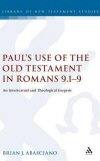
This investigation builds upon recent developments in the study of Paul’s use of Scripture that center around the concept of intertextuality. Abasciano’s exegetical method combines a thorough traditional exegesis with a comprehensive analysis of Paul’s use of Scripture. Abasciano does this by reading Romans in light of the interpretive traditions surrounding the texts to which Paul alludes, with great emphasis placed on analyzing the original contexts of Paul’s citations and allusions. Such an intertextual exegesis is conducted in Romans 9:1–9 with an awareness of the broader unit of chapters 9–11 especially, and also the epistle as a whole.
The study finds that many of the themes Paul deals with in Romans 9–11 are also present in ancient Jewish and Christian interpretive traditions surrounding the passages he invokes. More importantly, Paul’s scriptural quotations and allusions function as pointers to their broad original contexts, from which he developed much of the form, content, and direction of his argument, holding significance for a number of exegetical details as well as broader themes and rhetorical movements. The final chapter seeks to draw conclusions concerning the significance of Paul’s use of the Old Testament in Romans 9:1–9 for the exegesis and theology of Romans and for Pauline intertextuality. The identity of the true people of God is central to Romans 9–11 and the epistle. And Paul’s use of Scripture is contextual and referential, calling for attention to Pauline intertextuality in standard exegetical procedure.
. . . exceeds all expectations of a typical commentary in that it gives a thorough exegesis of all the OT allusions contained in the text, of which there are many. As such, it is also an OT commentary; OT exegetes will be remiss if they do not avail themselves of it. Moreover, Abasciano traces the occurrences of the alluded passages throughout Jewish literature, showing readers the range of interpretation of the OT text through the early rabbinic period and giving some indication of interpretive traditions that Paul might have known. As if this were not sufficiently ambitious, Abasciano keeps a vigilant eye on how these traditions might be compatible or incompatible with theological and philosophical issues that impact the Calvinist-Arminian controversy.
—James M. Leonard, Journal of the Evangelical Theological Society
[A] careful study of Paul’s use of the Old Testament. It has contributed to the growing body of literature on Pauline intertextuality by a thorough and in-depth analysis of Paul’s use of the Scripture in specific texts.
—Hon-Lee Kwok, Expository Times
I find Abasciano’s study convincing. It is marked by careful, detailed, and fully contextualized exegesis. At the same time, the author never loses sight of the big picture. Accordingly, Abasciano has provided us with a fine example of the synergy of exegesis and theology.
—Craig A. Evans, The Catholic Biblical Quarterly
As a whole, the monograph makes a fresh contribution to the study of Romans 9, particularly in strengthening and establishing the case for Paul’s use of Exodus 32 (denied by some scholars, such as E. Lohse). It is valuable for its survey of Jewish interpretations of the source texts used by Paul . . . It demonstrates how much a correct understanding of how Paul is using the Old Testament is vital for determining what he is arguing . . . The discussion of Paul’s view of election and calling is thus helpfully reopened.
—I. Howard Marshall, The Journal of Theological Studies
Brian J. Abasciano earned his PhD in divinity from the University of Aberdeen. He pastors at Faith Community Church in Hampton, New Hampshire, and serves as an adjunct professor of New Testament at Gordon-Conwell Theological Seminary.
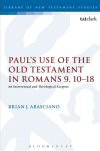
Brian Abasciano continues his project examining the use of the Old Testament in Romans 9. His method incorporates into a thorough traditional exegesis a comprehensive analysis of Paul’s use of Scripture against the background of interpretive traditions surrounding the texts alluded to, with great emphasis placed on analyzing the original contexts of Paul’s citations and allusions. Such an intertextual exegesis is conducted in Romans 9:10–33 with an awareness of the broader unit of chapters 9–11 especially and also the epistle as a whole.
Brian J. Abasciano earned his PhD in divinity from the University of Aberdeen. He pastors at Faith Community Church in Hampton, New Hampshire, and serves as an adjunct professor of New Testament at Gordon-Conwell Theological Seminary.
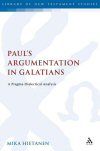
This volume approaches Galatians as a polemical letter which contains a substantial amount of argumentative passages. Paul evidently wanted to persuade by using the best arguments possible to convince his addressees. Using a state-of-the-art method from the discipline of argumentation analysis, Hietanen attempts to analyze Paul’s argumentation with a precision that standard exegetical methods cannot provide. The pragma-dialectical method developed in Amsterdam facilitates an analysis which is both descriptive and normative. On the one hand, Paul’s argumentation can be described, such as the relationship between premises and conclusions, the structure of the arguments, and features relating to rhetorical strategy. On the other hand, the method makes it possible to evaluate Paul’s argumentation against a set of rules for sound reasoning. Fallacies and problematic arguments can be described accurately. The spiritual nature of Paul’s theology does not relieve him of rationality, and Paul himself does not argue as if it did.
Paul’s argumentation is seen as problematic in several respects. There is a tension in the text: Paul works a great deal to argue his claims while at the same time giving the impression that he merely wants to declare his standpoints and does not want to carry out an argumentation at all. Many of the conclusions are presented as self-evident, even when they are not. Paul’s style is far from an ideal model of the resolution of a dispute. Paul relies heavily on an argumentative strategy with maximal use of rhetorical devices. The analysis shows that a pragma-dialectical method provides tools necessary to adequately describe and understand both individual arguments and the overarching strategy of the argumentation in this Pauline text.
Mika Hietanen is an assistant professor in rhetoric at Uppsala University.
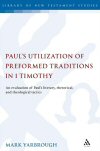
Paul’s Utilization of Preformed Traditions in 1 Timothy: An Evaluation of the Apostle’s Literary, Rhetorical, and Theological Tactics
- Author: Mark M. Yarbrough
- Series: The Library of New Testament Studies (JSNTS)
- Publisher: T&T Clark
- Publication Date: 2010
- Pages: 232
Mark Yarbrough assesses the question of whether traditional ‘preformed’ material contributes to the message and understanding of Paul’s first letter to Timothy. The issue is addressed in three sections. Part one evaluates previous works interacting with ‘traditional’ material in the New Testament. Through a critique of historically proposed criteria, Yarbrough identifies eight criteria as the primary tools by which to discern units of preformed material.
In the second part of the book Yarbrough evaluates 19 passages in 1 Timothy according to the criteria previously determined. From this base he embraces 12 of the 19 passages as preformed material. These passages are subsequently examined in depth according to the author’s distinct methodology. Part three demonstrates four functions of the preformed traditions in 1 Timothy. First, they strengthen the literary cohesion of the letter. Second, that the traditional units afford the author rhetorical leverage which may be best identified as the provision of authority, the establishment of an instant rapport with the primary audience, and the assistance conferred in addressing this implied audience. Thirdly, they present theological directives that confront the character and belief of the false teachers.
Finally, Yarbrough asserts that the preformed traditions exist as a combatant against counter-mission doctrine. This study concludes that the traditional material which may be discerned within the letter contributes significantly to the overall message and understanding of 1 Timothy.
Yarbrough’s work enhances the impression that the author of 1 Timothy is a writer of some skill: he has judiciously combined material from early Christian worship, creeds, and stories along with a wide array of (Pauline) sayings, letters, and biographical accounts in order to increase the authoritative force of the letter.
—Journal of Religion
Mark M. Yarbrough is vice president for communications, associate academic dean, and assistant professor of Bible exposition at Dallas Theological Seminary.

Paul and Isaiah’s Servants: Paul’s Theological Reading of Isaiah 40–66 in 2 Corinthians 5:14–6:10
- Author: Mark Gignilliat
- Series: The Library of New Testament Studies (JSNTS)
- Publisher: T&T Clark
- Publication Date: 2007
- Pages: 212
Paul’s reading of the Old Testament continues to witness to the significance of reading the Old Testament in a Christian way. This study argues that a theological approach to understanding Paul’s appeal to and reading of the Old Testament, especially Isaiah, offers important insights into the ways in which Christians should read the Old Testament and a two-testament canon today. By way of example, this study explores the ways in which Isaiah 40–66’s canonical form presents the gospel in miniature with its movement from Israel to Servant to servants. It is subsequently argued that Paul follows this literary movement in his own theological reflection in 2 Corinthians 5:14–6:10. Jesus takes on the unique role and identity of the Servant of Isaiah 40–55, and Paul takes on the role of the servants of the Servant in Isaiah 53–66. From this exegetical exploration, conclusions are drawn in the final chapter that seek to apply a term from the history of interpretation to Paul’s reading, that is, the plain sense of Scripture. What does an appeal to plain sense broker? And does Paul’s reading of the Old Testament look anything like a plain sense reading? Gignilliat concludes that Paul is reading the Old Testament in such a way that the literal sense and its figural potential and capacity are not divorced but are actually organically linked in what can be termed a “plain sense” reading.
Mark Gignilliat is an assistant professor of divinity at Beeson Divinity School, Samford University.
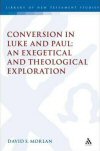
This study explores the conversion theologies of Luke and Paul. For Luke and Paul, conversion played an important role in the early Christian experience. Morlan offers a fresh look into how they interpreted this phenomenon. Morlan traverses representative texts in the Lukan and Pauline corpus equipped with three theological questions. What is the change involved in this conversion? Why is conversion necessary? Who is responsible for conversion?
Morlan presents theological and exegetical analysis of Luke 15, Acts 2 and 17:16–34, Romans 2 and Romans 9–11 to answer these questions, and, in turn, builds theological profiles for both Luke and Paul. These profiles provide fresh insight into the theological relationship between Luke and Paul, showing significant similarities as well as sharp contrasts between them. Similarities surface between Luke and Paul concerning the centrality of Christology in their conversion theologies. While showing a complex relationship between human and divine agency in conversion, both Luke and Paul understand successful conversion to be impossible without the intervention of an agency outside of the pre-convert.
David S. Morlan (PhD, Durham University) is a pastor at Fellowship Denver Church.
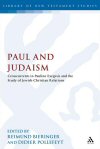
Paul and Judaism: Crosscurrents in Pauline Exegesis and the Study of Jewish-Christian Relations
- Editors: Reimund Bieringer and Didier Pollefeyt
- Series: The Library of New Testament Studies (JSNTS)
- Publisher: T&T Clark
- Publication Date: 2012
- Pages: 272
The ‘New Perspective on Paul’ cleared the Judaism of Paul’s day of the accusation that it was a religion based solely on works of righteousness. Reactions to the New Perspective, both positive and critical, and sometimes even strongly negative, reflect a more fundamental problem in the reception of this paradigm: the question of continuity and discontinuity between Judaism and Christianity and its assumed implications for Jewish-Christian dialogue. A second key problem revolves around Paul’s understanding of salvation as exclusive, inclusive, or pluralist.
The contributions in the present volume represent at least six approaches that can be plotted along this axis, considering Paul’s theology in its Jewish context. William S. Campbell and Thomas R. Blanton consider Paul’s Covenantal Theology, Michael Bachman provides an exegetical study of Paul, Israel, and the Gentiles, and Mark D. Nanos considers Paul and Torah. Chapters by Philip A. Cunningham, John T. Pawlikowski, Hans-Joachim Sander, and Hans-Herman Henrix give particular weight to questions of Jewish-Christian dialogue. The book finishes with an epilogue by pioneer of the New Perspective, James D. G. Dunn.
Reimund Bieringer is professor of New Testament, Katholieke Universiteit Leuven in Belgium
Didier Pollefeyt is professor of religious education and Jewish-Christian relations at the Katholieke Universiteit Leuven in Belgium.
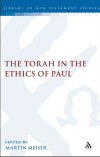
The relationship between Paul and Torah is often discussed in terms of Paul’s theology of salvation. However, it is also important in Pauline ethics. While some scholars dismiss this because of a paucity of Old Testament quotations in Paul, others hint at the consensus between Paul and early Jewish tradition concerning the content of single commands. Each of these positions holds consequences for describing the relationship between Paul and Judaism in general. In order to clarify the discussion, the contributors to this volume distinguish strictly between various levels of Pauline theology: the correspondence of single demands within Pauline and early Jewish ethics, the rationale of these single demands, and the general hermeneutical basis of ethics. This is done in the context of essays on the key Pauline passages pertaining to the debate. As such, this volume presents an up-to-date window into the current debate surrounding Paul, Torah, and Ethics and into the state of discussion surrounding Paul’s place within Judaism.
Martin Meiser is a professor in the Faculty of Theology at the University of the Saarland, Germany
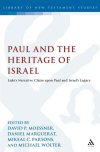
Paul and the Heritage of Israel: Paul’s Claim upon Israel’s Legacy in Luke and Acts in the Light of the Pauline Letters
- Editors: David P. Moessner, Daniel Marguerat, Mikeal C. Parsons, and Michael Wolter
- Series: The Library of New Testament Studies (JSNTS)
- Publisher: T&T Clark
- Publication Date: 2012
- Pages: 400
As a sequel to the hugely successful Jesus and the Heritage of Israel, this book brings together fourteen internationally acclaimed scholars in antiquities studies and experts on Paul and Luke. The contributors provoke new approaches to the troubled relation of the Lukan Paul by re-configuring the figure and impact of Paul upon nascent Christianity. Two leading questions serve as the basis of this volume—“Who are ‘Israel’ and the ‘church’ for Luke and Luke’s Paul?” and “Who is Jesus of Nazareth and who is Paul in relation to both?” The contributors provide challenging new perspectives on approaches to the figure of Paul in recent scholarship as well as in the scholarship of previous generations, “re-figuring” Paul by examining both how he is portrayed in Acts and how the Pauline figure of Acts may be envisioned within Paul’s own writings. Paul and the Heritage of Israel thus accomplishes what no other single volume has done: combining both the ‘Paul of Paul’ and the ‘Paul of Luke’ in one seminal volume.
David P. Moessner is professor of biblical theology at the University of Dubuque Theological Seminary.
Daniel Marguerat is professor of New Testament studies on the Faculty of Theology at the University of Lausanne in Switzerland. From 2007 to 2008, professor Marguerat served as the president of the Society for New Testament Studies and is a leading scholar in Luke and Acts.
Mikeal C. Parsons is Macon Chair and Professor of Religion at Baylor University. In addition to the works co-authored with Heidi J. Hornik, he is a contributor to the Baylor Handbook on the Greek New Testament series, Body and Character in Luke and Acts, and Luke: Storyteller, Evangelist, and Interpreter.
Michael Wolter is professor of New Testament at the University of Bonn, Germany.
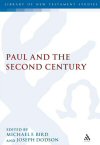
This is an examination of the apostle Paul within the Second Century, focused upon the writings of the Apostolic Fathers. This volume looks at the imprint and influence that the writings of the Apostle Paul had in the second century by examining the Pauline corpus in conjunction with key second century figures and texts, such as Ignatius, Polycarp, and the Epistle of Diognetus. As such, this volume is an exercise in the Wirkungsgeschichte or “effective-history” of Paul. It investigates the impact of Paul’s legacy and examines how this legacy shaped the Christianity that emerged in the second century as represented by the Apostolic Fathers, the early Christian Apologists, and Gnostic groups. The contributors are experts in their respective areas. Each contributor in turn examines how a given document or group reflects the influence of Paul’s life, letters, and theology and the various and even competing ways in which Paul’s legacy may be seen to have been appropriated. As such, this is the first volume to present an extended juxtaposition of Paul’s thought with such a wide selection of writings from the second century.
Michael Bird (PhD, University of Queensland, Australia) teaches New Testament and Greek at Highland Theological College in Scotland. He has published in several different academic journals including the Journal for the Study of the Historical Jesus, Currents in Biblical Research, Bulletin for Biblical Research, Tyndale Bulletin, Westminster Theological Journal, Trinity Journal, and Evangelical Quarterly. He is also the author of The Saving Righteousness of God.
Joseph R. Dodson is assistant professor of biblical studies at the Ouachita Baptist University.
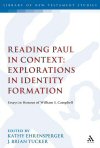
This new collection celebrates the distinguished contribution of William S. Campbell to a renewed understanding of Paul’s theologizing and its influence on the shaping of early Christian identity.
The essays are clustered around two closely related topics: Pauline theology, and the way it influenced Christian identity within the context of the Roman Empire. The essays consider the continued relevance of previous identities ‘in Christy’, the importance of the context of the Roman Empire, and the significance of the Jewishness of Paul and the Pauline movement in the shaping of identity. The political context is discussed by Neil Elliott, Ekkehard Stegemann, Daniel Patte, and Ian Rock. The Jewish roots of Paul and the Christ-movement are addressed in essays by Robert Jewett, Mark Nanos, Calvin Roetzel, and Kathy Ehrensperger. Paul’s specific influence in shaping the identity of the early Christ-movement is the concern of essays by Robert Brawley, Jerry Sumney, Kar Yong Lim, and J. Brian Tucker. Finally, methodological reflection on Paul’s theologizing within Pauline studies is the concern of essays by Terrence Donaldson and Magnus Zetterholm.
. . . the quality of the essays is considerable.
—Religious Studies Review
Kathy Ehrensperger is a reader in New Testament studies at the University of Wales, Trinity Saint David. She is the author of That We May Be Mutually Encouraged
J. Brian Tucker is an associate professor of New Testament at Moody Theological Seminary.
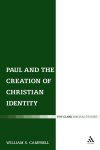
One reconstruction of first-century Christianity views Paul as separating from Peter and Jewish Christianity to lead his own independent mission which was eventually to triumph in the creation of a church with a gentile identity. It is claimed, however, that Paul’s gentile mission, represented only one strand of the Christ movement which has been universalized to signify the whole. Thus, the earliest diversity in which he operated and which he affirmed has been anachronistically diminished almost to the point of obliteration. There is little recognition of the Jewish form of Christianity or that Paul, by and large, related positively to it as evidenced in Romans 14–15. Here Paul acknowledges Jewish identity as an abiding reality rather than as a temporary and weak form of faith in Christ. This book argues that diversity in Christ was fundamental to and recognized by Paul, particularly in his ethical guidance. Paul’s relation to Judaism is best understood not as a reaction to his former faith but as a transformation resulting from his vision of Christ. In this the past is not obliterated but transformed. Thus, continuity is maintained so that the identity of Christianity is neither that of a new religion nor of a Jesus cult. In Christ the past is reconfigured and the diversity of humanity continues within the church, which can celebrate the richness of differing identities under the Lordship of Christ.
A rich and illuminating study . . . The author has produced a highly readable scholarly monograph with an attractive thesis.
—Theology
Campbell’s study is an important assessment of the role of identity formation in Paul’s thinking. It advances the discussion of Pauline thought in creative and significant ways.
—Expository Times
William Campbell’s study is a valuable contribution to our understanding of Christian identity formation in the first century CE . . . His grasp of the material is commendable, as is the precision with which he writes.
—Ralph J. Korner, Bryn Mawr Classical Review
This book should be read by Pauline scholars, especially those working in Romans. Campbell’s creativity and ability to sustain an argument makes this work well worth the time invested and provides a much-needed perspective in the current debate on identity formation in early Christianity.
—Criswell Theological Review
Campbell presents some compelling arguments as he charges the ‘New Perspective’ with not being radical enough in challenging Christian anti-Jewish rhetoric.
—Alan Le Grys, Journal for the Study of the New Testament
William S. Campbell is a reader in biblical studies at the University of Wales. He is the author of Paul’s Gospel in Inter-Cultural Context and editor of the Journal of Beliefs and Values.
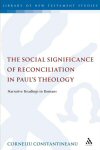
This is an assessment of the social dimension to reconciliation as displayed in Paul’s Letter to the Romans. Traditional exegetical scholarship has treated Paul’s presentation of reconciliation as referring to reconciliation between people and God, and has primarily focused on the use of the word κατταλαγη—traditionally translated as ‘atonement.’ Constantineanu challenges this view and argues that Paul’s understanding of the concept is more complex, employing rich symbolism to describe reconciliation with God and between human beings forming together an inseparable reality. The discussion is placed within Paul’s overall religious, social and political contexts, showing that an analysis of the social dimension of reconciliation in his thought is both plausible and necessary. Constantineanu offers an analysis of two major sections of Romans, chapters 5–8 and 12–15. Special emphasis is placed on Paul’s use of the story of Jesus for community formation, for the shaping of identity, values, and community practices. It is thus demonstrated that, for Paul, God’s reconciling initiative, shown in the crucifixion, is not only the pronouncement of God’s reconciling the world, but also the ground and model for reconciliation among human beings.
Informative and well-written, it will make a significant contribution to Pauline studies . . . Paul would, I think, be pleased with this application of his theology of reconciliation . . . Constantineanu’s book is a welcome demonstration, both for Pauline scholars and for Christians living in conflict-divided communities, of the power of the gospel of God to make broken and wounded relationships a new creation.
—Theology
In addition to its unusual relevance for the situation of religious competition, this well-written and carefully documented study provides a healthy reorientation in interpreting the reconciliation theme in Romans and elsewhere. It introduces a significant new voice in the current ecumenical discourse in Pauline theology and ethics. This book is strongly recommended for pastors and students.
—Review of Biblical Literature
This book . . . should be read by anyone interested in studying religion’s role in reconciling earthly conflicts. Scholars interested in a narrative analysis of biblical texts, and in the theology of the NPP should also read this book.
—Reviews in Religion & Theology
Corneliu Constantineanu is associate professor of New Testament and biblical interpretation, and academic dean at the Evangelical Theological Seminary in Osijek, Croatia. He has received his PhD from the University of Leeds and has published mainly in the area of Pauline theology and reconciliation.
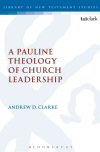
Scholarly studies considering Paul’s views on leadership tend to fall into one of three camps: 1) the historical development view, which in large measure identifies developments in church practice with developments in Pauline and deutero-Pauline ecclesiology; 2) the synchronic, historical reconstruction, typically making use of Greco-Roman, social context sources, or social-scientific modeling, focusing on a single congregation, and sometimes distinguishing between the situation to which Paul was responding and the pattern he sought to impose; and 3) the theological/hermeneutical analysis, identifying Paul’s particular approach to power and authority, often independently of any detailed reconstruction of the situations to which Paul was responding. Andrew Clarke has explored in an earlier work, Serve the Community of the Church, the distinctive, local, and historical situations in the various Pauline communities and concluded that there is no evidence that they organized themselves according to a common set of governmental structures which clearly developed with the passage of time. Rather each community was influenced by its own localized, social, and cultural context. The present project builds on this and focuses on leadership style rather than church order. It seeks to recover from Paul’s critical responses and his generic ethos of church leadership the characteristics, ideal qualities, and task of leaders and the nature of appropriate interaction and engagement with church members. In the light of current, theoretical discussions about power and gender, this study focuses particularly on Paul’s attitude towards hierarchy, egalitarianism, authority, responsibility, and privilege.
This study extends Clarke’s previous work on leadership in the early church . . . This is a far more wide-ranging study, and assesses the whole Pauline corpus to address the issue of the way Paul’s understandings of leadership impacts his conceptions of ecclesiology. This work reflects the mature thought of a scholar who has wrestled with questions of Pauline leadership throughout his academic and pastoral career and readers will benefit from the insights offered.
—Expository Times
Clarke’s theological analysis of Pauline leadership is recommended for anybody interested in the topic . . . A Pauline Theology of Church Leadership fills an important gap in contemporary scholarship by collating the fundamental teachings of Paul on an important ecclesiological theme . . . Clarke’s compilation of Pauline leadership principles is an excellent contribution in many ways. His awareness of significant tensions within both the Pauline literature and contemporary scholarship deeply informs his theological queries. Moreover, Clarke’s expertise in NT social history surfaces throughout as he illuminates many details pertaining to the original context of Paul’s letters. Finally, Clarke’s analyses of concepts such as power, rhetoric, and imitation demonstrate his attentiveness to the inner workings of the apostle, which have previously been overlooked in shallower theologies . . . Clarke has produced an erudite and thought-provoking volume which will be a tremendous resource for any scholar, pastor, or student interested in this topic.
—European Journal of Theology
This work makes a positive contribution in the area of Pauline ecclesiology. Clarke presents a nuanced work that takes into consideration much of the literature written from a critical perspective on Paul and his churches. He also bases his views upon a historical reconstruction that takes into account the relevant data from Paul’s letters as well as current information gained by historical and sociological studies.
—Journal of the Evangelical Theological Society
In this fascinating new monograph, Andrew Clarke addresses the impact of Paul’s view on leadership within the parameters of the early Christian communities that he planted, as well as the impact thereof on Paul’s ecclesiology.
—Stephan Joubert, Review of Biblical Literature
Andrew Clarke is senior lecturer in New Testament at the University of Aberdeen. His other books include Secular and Christian Leadership in Corinth: A Socio-Historical and Exegetical Study of 1 Corinthians 1–6, and Serve the Community of the Church: Christians as Leaders and Ministers.
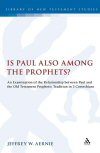
Is Paul also among the Prophets?: An Examination of the Relationship between Paul and the Old Testament Prophetic Tradition in 2 Corinthians
- Author: Jeffrey W. Aernie
- Series: The Library of New Testament Studies (JSNTS)
- Publisher: T&T Clark
- Publication Date: 2012
- Pages: 320
Jeffrey W. Aernie examines the prophetic material in the Old Testament and its relationship with the prophetic material in Second Temple Judaism, Hellenism, and the early Christian movement. The subsequent analysis of 1 Corinthians constitutes an investigation of the effect of the Old Testament prophetic tradition on Paul’s self-presentation in 1 Cor 9:15–18 and rhetorical framework in 1 Corinthians 14:20–25 as a methodological foundation for the exegetical analysis of 2 Corinthians.
The analysis of Paul’s self-presentation examines the apostle’s relationship with Moses, the Isaianic servant, and Jeremiah in order to define Paul’s position with regard to the preceding prophetic tradition. Aernie’s analyses of Paul’s argument in 2 Corinthians 2:14–16, 4:1–6, 6:14–7:1, and 12:1–10 then seeks to examine the influence of the Old Testament prophetic tradition on the formation of Paul’s rhetorical framework. Aernie’s intention is to provide support for the notion that the particularly prophetic nature of Paul’s apostolic persona affects both his self-presentation and rhetorical agenda in 2 Corinthians.
Jeffrey W. Aernie received his PhD from the University of Aberdeen and is lecturer in New Testament at United Theological College at Charles Sturt University in Australia.
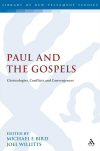
This volume, which collects together the work of several established scholars, attempts to situate the Apostle Paul, the Pauline writings, and the earliest Christian Gospels together in the context of early Christianity. It addresses the issue of how the Christianity depicted in and represented by the individual Gospels relates to the vision of Christianity represented by Paul and the Pauline writings. This raises such questions as to what extent did Paul influenced the canonical and non-canonical Gospels? In what way are the Gospels reactions to Paul and his legacy? A comparison of the Gospels and Paul on topics such as Old Testament Law, Gentile mission, Christology, and early church leadership structures represents a fruitful area of study. While a number of volumes have appeared that attempt to assess the relationship between the historical Jesus and the Apostle Paul, relatively few studies on Paul and the Gospels have been published. This volume excellently fills this gap in New Testament studies and makes a valuable contribution to studies on Christian origins, Pauline research, and the Gospels.
Michael Bird (PhD, University of Queensland, Australia) teaches New Testament and Greek at Highland Theological College in Scotland. He has published in several different academic journals, including the Journal for the Study of the Historical Jesus, Currents in Biblical Research, Bulletin for Biblical Research, Tyndale Bulletin, Westminster Theological Journal, Trinity Journal, and Evangelical Quarterly. He is also the author of The Saving Righteousness of God.
Joel Willitts is associate professor of biblical and theological studies at North Park University in Chicago.
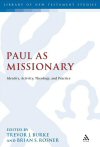
Paul as Missionary: Identity, Activity, Theology, and Practice
- Editors: Trevor J. Burke and Brian S. Rosner
- Series: The Library of New Testament Studies (JSNTS)
- Publisher: T&T Clark
- Publication Date: 2011
- Pages: 288
This volume takes the view that, before anything else, Paul must first and foremost be identified as a missionary. Using the entire Pauline corpus, the contributors to this volume assess what Paul’s correspondence can tell us about how he perceived his role and identity. The work comprises four parts: in section one, Paul’s identity as priest, eschatological herald, and missionary-pastor are explored while in part two topics such as the apostle’s activity among pagans, his suffering, and Paul’s missionary message to the church at Rome are considered. Section three comprises essays on the Spirit as the governing dynamic, the glory of God as the apostles missionary goal, and the importance of Paul’s Christology in shaping his mission to the Gentiles. Finally, part four addresses Paul’s missionary praxis, including his support of his missionary enterprise.
Trevor J. Burke teaches New Testament in the Bible department of the Moody Bible Institute in Chicago. Prior to this, he has taught New Testament in seminaries in Nigeria and Fiji.
Brian S. Rosner received his PhD from Cambridge University and is senior lecturer in New Testament and ethics at Moore Theological College in Sydney, Australia. He is the author and editor of a number of books, including The First Letter to the Corinthians in the Pillar New Testament Commentary series, the New Dictionary of Biblical Theology, and Understanding Paul’s Ethics.
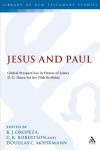
Jesus and Paul: Global Perspectives in Honour of James D. G. Dunn. A festschrift for his 70th Birthday
- Editors: B. J. Oropeza, Douglas C. Mohrmann, and C. K. Robertson
- Series: The Library of New Testament Studies (JSNTS)
- Publisher: T&T Clark
- Publication Date: 2010
- Pages: 272
James D. G. Dunn has been one of the most influential New Testament scholars of the late twentieth and early twenty-first centuries. His works have altered the very way biblical theologians view Jesus and Paul. This book is written in gratitude to his influence and mentorship. The focus of the work parallels the major research of Dunn’s career. It emphasizes the life and teachings of Jesus as remembered by his disciples, the new perspective on Paul, teachings in the Pauline letters, and relevant topics related to ancient Judaism, the Law, Soteriology, and Christology in the New Testament.
In 2005 a festschrift for James D. G. Dunn’s 65th birthday was published with essays by Professor Dunn’s many colleagues and friends. In this volume, a new generation of scholars, who are being widely recognized for their own contributions and publications, now honor their former teacher and demonstrate to the scholastic community the breadth of his influence.
The themes of this book are very diverse, but the quality of contributions is generally high. This is an interesting volume honoring a very fine scholar.
—Journal for the Study of The New Testament
B. J. Oropeza is associate professor of biblical Studies at Azusa Pacific University. He is founder and chair of the Intertextuality in the New Testament Consultation (SBL).
Douglas C. Mohrmann is associate professor of religion at Cornerstone University. Dr. Mohrmann co-founded and directed the Center for the Study of Antiquity and continues to research and publish on topics related to Early Judaism, Paul, and American Religion. He currently leads the Ancient Studies program at Cornerstone University.
C. K. Robertson is Canon to the Presiding Bishop of The Episcopal Church, a former professor of communications, and ethics at Georgia College & State University, and a Fellow of the Episcopal Church Foundation. Dr. Robertson presently serves on several national boards, including the Anglican Theological Review, is a member of the Anglican Association of Biblical Scholars, and author or editor of numerous books and articles.
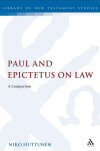
Paul’s relationship with covenantal nomism has long been the subject of lively discussion. In this book, Niko Huttunen presents a challenging new path to complement the general scholarly picture of Paul’s teaching on law. Acknowledging that Stoicism permeated Paul’s intellectual milieu, Huttunen compares Paul’s sayings of law with those of Epictetus, drawing comparisons as a result of careful methodological considerations.
Pauline law is generally focused upon Paul’s sayings on and relationship with the Torah. It is Huttunen’s contention that Paul’s ideas on law have clearer affinities with Stoic ideas than with the Torah. Throughout the course of the book Huttunen displays Paul’s interpretation of the Torah with Stoic methods (1 Cor. 7–9), asserts that in some passages (Rom. 1–2 and Rom. 7), Paul’s thinking is Stoic, not Platonic, and demonstrates that Paul’s famous “I”-passage (Rom. 7:7–25) owes much to Stoic anthropology and psychology. Where the latter is concerned, Huttunen suggests that Epictetus’ use of the first person presents a good analogy for Paul’s employment of “I” as a rhetorical device. In further passages (e.g. Rom. 13–15) the comparison with Epictetus opens a window into ancient intellectual thinking in general. Epictetus’ ideas of moral progress present an analogy to the “works of law” and to Paul’s moral exhortation. There are also similarities between Paul’s figure of Christ and Epictetus’ figure of Heracles. The comparison suggests further comparisons between Paul’s treatment of law and other philosophers and schools.
As a salutary supplement to the customary approaches of the ‘old’ and ‘new’ perspectives on Paul, this is an initial foray into an area that merits further study.
—Religious Studies Review
While some of his readings of Paul and (the) law will probably be controversial to scholars, Huttunen has succeeded in opening up new ways of approaching this difficult topic. At the same time, he has provided a valuable presentation of Stoic theory as expressed by Epictetus with a number of useful textual examples. One of the greatest strengths of Huttunen’s study is precisely his careful and insightful analysis of Epictetus’s lectures, which will undoubtedly prove helpful to Pauline scholarship, far beyond studies of Paul and law.
—Journal of Religion
Niko Huttunen is a researcher in New Testament studies at the University of Helsinki, Finland. He has published articles on Wirkungsgeschichte of the Bible and on the relationship between Stoicism and the New Testament.
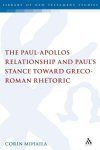
Paul-Apollos Relationship and Paul’s Stance toward Greco-Roman Rhetoric: An Exegetical and Socio-historical Study of 1 Corinthians 1–4
- Author: Corin Mihaila
- Series: The Library of New Testament Studies (JSNTS)
- Publisher: T&T Clark
- Publication Date: 2009
- Pages: 272
Research into the social and rhetorical background of the Corinthian church, shows that the Corinthians were evaluating their leaders based on their rhetorical prowess, seeking to associate with those who would enhance their status and honor. The coherence of Paul’s argument in 1 Corinthians 1–4 is evaluated, particularly by showing how Paul’s discourse of the cross and Sophia relate to the issue of the dissensions in the Corinthian ekklesia. Once demonstrated that there is a misunderstanding of wisdom amongst church leaders at the basis of the dissensions, a redefinition of the wisdom offered in Corinthians is required.
In what could be considered the locus of Paul’s theology of proclamation (i.e., 1 Corinthians 2:1–5), he rejects any employment of worldly wisdom in his proclamation of the cross for theological reasons and will not allow himself or other leaders to be drawn into this game of personality cult and honor enhancement.
Such conclusions then raise the question of the role played by Apollos’ name in Paul’s argument against dissensions. After a review of several possible views, it is concluded that Paul had a congenial relationship with Apollos. If any distinction is drawn between the two, it was solely the Corinthians’ fault, who viewed their preachers in competitive rather than complementary terms.
Corin Mihaila is adjunct professor at Liberty University in Lynchburg, VA and the senior pastor of First Baptist Church in Brasov, Romania.
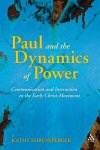
In this illuminating study, Kathy Ehrensperger looks at the question of Paul’s use of power and authority as an apostle who understands himself as called to proclaim the Gospel among the gentiles. Ehrensperger examines the broad range of perspectives on how this use of power should be evaluated. These range from the traditional interpretation of unquestioned Apostolic authority, to a feminist interpretation. She examines whether or not Paul’s use of power presents an open or hidden reinscription of hierarchical structures in what was previously a discipleship of equals.
Paul and the Dynamics of Power questions whether such hierarchical tendencies are correctly identified within Paul’s discourse of power. Furthermore it considers whether these are inherently and necessarily expressions of domination and are thus in opposition to a “discipleship of equals?” In her careful analysis, Ehrensperger draws on such wide-ranging figures as Derrida, Michel Foucault, and James Scott. This enables fresh insights into Paul’s use of authority and power in its first century context.
Ehrensperger’s study is an excellent (re)consideration of the Pauline exercise of power in light of contemporary thought. Impressively, she takes seriously both the historical context of the early church and the language and concepts of recent studies on power . . . The result is a well-balanced reading of the Pauline discourse of power which will benefit those interested in the social dynamics of early Christianity and Paul in general.
—Expository Times
Overall the book is well-written and extremely well-researched. The author particularly shines when discussing contextual backgrounds for the various topics in the study. Ehrensperger’s understanding of Paul’s Jewish background and the context out of which Paul fulfills his apostolic calling is especially beneficial. The book is worth reading alone for the backgrounds provided on ancient education, family groups, and social networks. Ehrensperger integrates sociological and exegetical methods into seamless explanation of Paul’s communications with the early Christ-following communities . . . Perhaps the book’s greatest strengths are the implications that it provides for Christian leaders today.
—Kenneth R. Solomon, Criswell Theological Review
Kathy Ehrensperger is reader in New Testament studies, University of Wales, Trinity Saint David. Kathy is the author of That We May Be Mutually Encouraged.
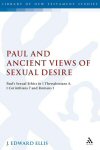
This volume seeks to refute the argument put forward by some scholars that Paul, in his sexual ethics, is in partial agreement with a current of thought in the Greco-Roman world condemning sexual desire and advocating the elimination of such desire from marital sex. Ellis also addresses Paul’s comments on homosexual activity in Romans 1.
Through close analysis of numerous ancient passages relating to sexual desire, Ellis demonstrates that ancient thinkers do not tend to condemn sexual desire in itself, but excessive sexual desire and lack of self-control. Furthermore, he contends that ancient auditors would have been unlikely to see condemnation of sexual desire in Paul’s words in 1 Thessalonians 4 or 1 Corinthians 7.
J. Edward Ellis is an ordained United Methodist minister and assistant professor of New Testament at Olivet Nazarene University. His other publications include Controlled Burn: The Romantic Note in 1 Corinthians 7.
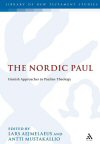
This book contains essays on the letters and theology of the Apostle Paul from leading Pauline scholars. The majority of the essays are based on papers given at the first Finnish national seminar on Paul held at the University of Helsinki.
Finnish contributions to scholarly discussion on Pauline theology have been widely recognized as challenging and thought-provoking, particularly in regards to Paul’s view on the Mosaic Law and soteriology. Heikki Räisänen’s view on Paul’s inconsistent thinking about Mosaic Law and other topics has served to polarize discussion among Finnish scholars. The opening essay by Stephen Westerholm outlines the debate and its relation to international discussion. The essays by Heikki Räisänen, Kari Kuula, and Timo Laato are fruits of this ongoing discussion. Niko Huttunen approaches the question of Paul and the Mosaic Law from the Stoic point of view, while Risto Saarinen examines its relation to the theology of Martin Luther.
Other principal topics include Paul’s opponents and methodological discussion. A comprehensive way to analyze Paul’s argumentation is sought in Mika Hietanen’s essay. Lauri Thurén examines how Paul’s rhetoric must be taken into account when deciphering historical information from his letters. His essay takes Paul’s opponents as an example. The opponents are also dealt with by Lars Aejmelaeus and Nina Pehkonen. Their essays focus on anti-Pauline opposition in Corinth and the antagonists in Philippians, respectively.
This collection of essays offers a number of fresh perspectives and ideas that will stimulate the discussion of Paul’s theology well beyond Finland.
—Filologia Neotestamentaria
Finnish scholarship presents a microcosm of Pauline studies, offering a similarly wide range of answers to the same questions that are central elsewhere in the guild. One need not be Finnish to profit from the ongoing discussion and original contributions contained in this volume.
—Patrick Gray, Religious Studies Review
Lars Aejelaeus is professor of biblical studies in the Department of Biblical Studies at the University of Helsinki in Finland.
Antti Mustakallio is researcher in the Department of Biblical Studies at the University of Helsinki in Finland.
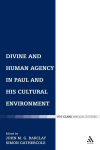
Since the work of E. P. Sanders, most modern approaches to this topic have been focused on social or sociological aspects of the issue—particularly in relation to Paul’s mission to the Gentiles. However, the last few years have seen an increasing willingness to open up questions seemingly ‘settled’ in the New Perspective, and a renewed desire to examine the structures of theology concerning grace and human action both in Paul and in his contemporary Judaism. It now seems worthwhile to examine to what extent there was an internal debate within Judaism about divine grace and its relation to human agency, and whether this debate could or did spawn various more or less radical solutions.
The aim of this volume is to reexamine Paul within contemporary Jewish debate on this topic, attuned to the significant theological issues he raises without imposing upon him the frameworks developed in later Christian thought.
. . . With contributions by nine first-rate scholars . . . this volume [is] a must read for everyone interested in an update on this often hotly-debated topic.
—Expository Times
John M.G. Barclay is Lightfoot Professor of Divinity at the University of Durham.
Simon J. Gathercole is lecturer in New Testament at the University of Cambridge.
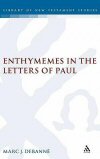
This investigation looks at Paul’s argumentation with special attention paid to enthymemes. An enthymemes is a three part deductive argumentation with an unstated assumption. Enthymemes constitute an important part of Paul’s argumentation which, until now, has been relatively unexplored. This study of the manner in which Paul constructs enthymemes gives us insight into his thought.
[This] book repays careful study. The technical side is not unduly daunting, and the exegesis is usually illuminating and interesting across a range of intrinsically interesting issues and texts . . . The author admits that what he finds is already ‘perceivable by any informed and careful reader,’ but perception is sharpened and informed by his methodology and its application. He makes a useful contribution to our understanding of each of the letters, and more.
—John Dunnill, Expository Times
Marc J. Debanne is the national director of Les Groupes Bibliques Universitaires du Canada. He has a PhD in New Testament studies from McGill University in Montreal.
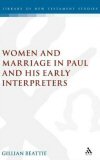
In this volume, Beattie undertakes a comparative survey of the treatment of women and marriage in three different kinds of texts: 1) those generally viewed as authentically Pauline—namely, 1 Corinthians; 2) the deutero-Pauline literature—Colossians, Ephesians, and the Pastoral Epistles; and 3) some tractates from the Nag Hammadi Library—giving particular attention to the Gospel of Philip, the Exegesis on the Soul, the Hypostasis of the Archons, and the Gospel of Thomas. The theoretical position she takes is based upon the neopragmatist thought of Richard Rorty and Stanley Fish, Rorty’s notions of ‘contingency’ and ‘redescription’ being of particular importance.
The aim of this book is twofold. It seeks to draw attention to the contingency (that is to say, the situatedness and vested interests) attendant on all acts of interpretation. It also seeks to engage in a redescription of the category of “Gnosticism” to which the Nag Hammadi texts have traditionally been assigned, and thus also of the canonical texts as seen in relation to them. It is not the intention to suggest in a simplistic fashion that the Nag Hammadi texts should somehow displace the canonical documents as the “correct” reading of Paul, but rather to show that texts can be read in ways as diverse and numerous as the goals of their interpreters.
Beattie’s discussion of the Nag Hammadi Texts will interest scholarly colleagues . . . In short, her focus on the importance of context and the vital role played by the presuppositions and interests of individuals and communities in both the writing and reading of texts has ongoing value not only for the scholarly reader, but more particularly, for the nonspecialist.
—J. Dorcas Gordon, Biblical Theology Bulletin
A book with original insights.
—International Review of Biblical Studies
Gillian Beattie is a graduate of the University of St. Andrews and Princeton Theological Seminary. She received her PhD from the University of Manchester.
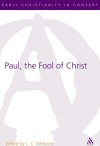
Welborn argues that Paul’s acceptance of the role of a “fool” and his evaluation of the message of the cross as “foolishness” are best understood against the background of the popular theater and the fool’s role in the mime. Welborn’s investigation demonstrates that the term “folly,” μωρια was generally understood as a designation of the attitude and behavior of a particular social type—the lower class buffoon. As a source of amusement, these lower-class types were widely represented on the stage in the vulgar and realistic comedy known as the mime. Paul’s acceptance of the role of the fool mirrors the strategy of a number of intellectuals in the early Empire who exploited the paradoxical freedom that the role permitted for the utterance of a dangerous truth.
Welborn locates Paul’s exposition of the “folly” of the message about the cross in a submerged intellectual tradition that connects Cynic philosophy, satire, and the mime. In this tradition, the world is viewed from the perspective of the poor, the dishonored, and the outsiders. The hero of this tradition is the “wise fool,” who, in grotesque disguise, is allowed to utter critical truths about authority. The book demonstrates that Paul participates fully in this tradition in his discourse about the folly of the word of the cross. The major components of Paul’s argument in 1 Corinthians 1–4 find their closest analogies in the tradition that valorizes Socrates, Aesop, and the mimic fool.
This stimulating presentation proposes an ingenious hypothesis for understanding Paul’s imagery in 1 Corinthians 1–4 . . . Welborn’s monograph is worth careful attention.
—Russell Morton, Review of Biblical Literature
. . . This rich study is warmly recommended.
—F. Gerald Downing, Journal for the Study of the New Testament
. . . Both innovative and controversial.
—Paul Foster, Expository Times
Paul, the Fool of Christ contains much detail about the mime from Greco-Roman society that will benefit the study of New Testament backgrounds.
—H. H. Drake Williams III, Themelios
L. L. Welborn
is professor of New Testament and Early Christianity at Fordham University in New York. He is the author of Early Patristic Readings of Romans and Politics and Rhetoric in the Corinthian Epistles and coeditor of Encounters with Hellenism: Studies in First Clement.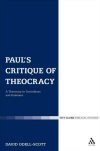
Paul’s Critique of Theocracy offers an interpretation of selected texts in Corinthians and Galatians concerned with the establishment of legitimate authority in the Christian community. Odell-Scott argues that for Paul, no one may boast that they are selected by God, and no one has the authority to rule as God’s representative.
Paul also criticizes those who exhibit a superior “sacredness” over other community members. Contrary to most scholarly views, Odell-Scott argues that Paul is not taking sides in a debate about the proper authority structure. Rather, he criticizes any notion of such a structure, opposing it with his metaphor of the Church as the body of Christ and the “sacred family” of God. The exegesis is also sketched out in a postmodern framework criticizing hierarchy through differentiation.
This book presents a fresh reading of texts from the Corinthian correspondence and Galatians.
—Encounter
David Odell-Scott is professor and chair of philosophy and coordinator of religion studies at Kent State University in Ohio.
Reviews
2 ratings

Richard D. Villanueva Sr.
1/31/2023

Unix
8/5/2013
This collection will probably be one of four that I buy within a decade that cost $290 or more each, (starting about month ago when I ordered the New Interpreter's Dictionary of the Bible as printed matter). I did a calculation of how many useful interesting pages there would approximately be in this collection, and concluded that those pages would cost me ¢10¼ a page on pre-pub. That's average value for academic titles on very specific topics. Some of the topics discussed are of great value to me. I dismiss some of the volumes because they are both not interesting/useful to me, and seem to be initiated/topic chosen because each day someone doctorates. Expressed differently: the collection has so many topics that I don't have interest in all those topics. I'm not in a hurry to read this collection, but I wouldn't purchase volumes individually as I want to read just a part of many of the books. This collection is also pretty unique at the moment for a specific theological collection in that it deals a bit with "Gnosticism" and in that it also includes negative criticism of the NPP. I look forward to using during my lifetime just above ½ of the pages of this inquisitive collection. Pauline studies are important, but as I don't know Your opinions I can't say whether I recommend You to buy. I don't buy the NPP and I think "Gnosticism" is important. Logos has very little on the latter and as I haven't found much as printed matter either, yet, I have very few "Gnosticism" books (just two obvious ones).